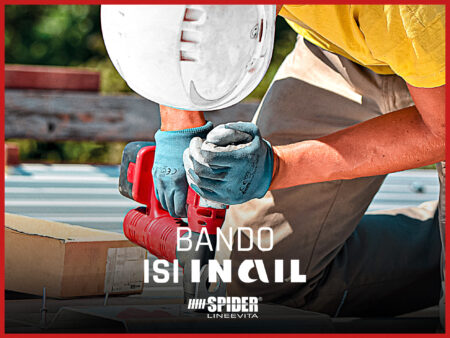A temporary lifeline is a temporary safety installation, characterized by a load-bearing structure, connected to an anchoring network, which allows operation at height and guarantees protection from any falls, can be installed to ensure maximum safety for operators during maintenance and work on the roof. The reference legislation for these devices is governed by the general safety requirements (RGS) provided for by Law 81/2008.
It represents a valid solution in environments where it is not possible to install or provide a permanent anchoring system, providing high protection against falls, especially if the system is in good condition.
According to current regulations, the temporary lifeline must be designed by a qualified professional, and must be appropriately sized to meet regulatory requirements. In the same way, it is essential that it is regularly checked and inspected, both by a specialized company and by qualified personnel, to ensure that all components are in good condition and comply with the standards set by the reference technical standards.
To ensure the compliance of the safety system, it is necessary that the components of the temporary lifeline are indicated in the DVR (Risk Assessment Document). The DVR must also indicate which is the safest route to follow at altitude.
The temporary lifeline must also be installed, regularly checked and inspected by a company experienced in the design and control standards of safety systems. It is essential that the installation meets all the requirements of current regulations in order to obtain maximum safety, and all elements must be tested in advance to verify their efficiency.
Being a temporary safety system, the temporary lifeline must not be installed on rough or uneven surfaces, so as to minimize the possibility of accidents during use.
Temporary lifelines provide a practical and safe solution for working at high heights. They can be installed quickly during construction and are designed to ensure exceptional safety for workers.
Temporary lifelines offer several benefits:
In addition, temporary lifelines are regulated by UNI EN 795, which establishes the criteria for the use of anchoring lines connected to a detention system or to the final part of the anchor line itself. This legislation is applicable in all scenarios where it is necessary to operate at high altitudes.
A temporary lifeline installation is an important system for securing people working on high shelves, roofs and balconies. But before installing a temporary lifeline, there are some prerequisites that need to be considered:
The size of the work surface is an important factor to consider. The surface area must be large enough to ensure that security systems have enough space to be adapted to the area.
The type of structure on which you intend to install the temporary lifeline will determine what type of anchor and connecting system can be used. If the structure cannot guarantee the structural integrity of the system, normal anchors and connections cannot be used.
It is important to know the load-bearing capacity of the area before installing a temporary lifeline.
Temporary lifelines, as described in Legislative Decree 81/2008 and Legislative Decree 106/2009, are tools aimed at ensuring the safety of workers operating at height.
According to this regulation, lifelines must undergo periodic inspection by a qualified professional to ensure that they meet the necessary safety requirements. Lifelines must also be designed and manufactured by qualified personnel in accordance with technical standards.
Another important aspect is that temporary lifelines must be removed after use, and therefore there are limitations on the duration of their use. In addition, a visual inspection must be carried out before each use to ensure that they do not show signs of wear or damage.
A temporary lifeline, or anchoring system, is a means of safety that protects workers from accidents while performing work at height. However, to ensure maximum safety, it is necessary to ensure that workers wear all the required personal protective equipment correctly.
The most commonly used personal protective equipment when installing a temporary lifeline are:
Temporary lifelines must be maintained periodically and audited to ensure they are in good safety. The maintenance and verification requirements for temporary lifelines are regulated by Legislative Decree 81/2008 – Consolidated Law on safety in the workplace.
According to the legislation, lifelines must be subject to periodic verification by qualified personnel at least once a year. During this audit, lifeline components should be inspected for damage, wear, or corrosion. If necessary, qualified personnel can also test the lifelines with dynamic and static tests to ensure that they can withstand the expected load and any other accidental load that may occur during their use.
In addition, other general requirements are available that must be met in order for temporary lifelines to be considered suitable for use in construction work.
In conclusion, temporary lifelines, although they are considered an important protection system, must be strictly contingent on the relevant safety regulations. No less important is the inclusion of adequate personal protection systems and anchoring devices in accordance with the law.
Interim lifelines help ensure the safety of workers and users in high-risk work environments, but the serious dangers associated with these systems cannot be underestimated. Therefore, it is essential to ensure that they are installed in accordance with the provisions of safety legislation.
 Agevolazioni
Agevolazioni  Events
Events